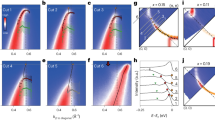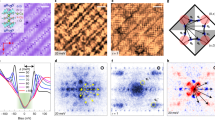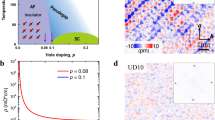Abstract
Superconductivity in copper oxide (cuprate) high-transition-temperature superconductors follows from the chemical doping of an antiferromagnetic insulating state. The consensus that the wavefunction of the superconducting carrier, the Cooper pair, has symmetry1,2 has long been reached. This pairing symmetry implies the existence of nodes in the superconducting energy gap. Recently, a series of angle-resolved photoemission spectroscopy experiments3,4,5,6,7,8,9 have revealed that deeply underdoped cuprates exhibit a particle–hole symmetric3 superconducting-like energy gap at the momentum–space locations where the gap nodes are expected. Here we discuss the possibility that this phenomenon is caused by a fully gapped topological superconducting state that coexists with the antiferromagnetic order. If experimentally confirmed, this result will completely change our view of how exactly the high-temperature superconductivity state evolves from the insulating antiferromagnet.
This is a preview of subscription content, access via your institution
Access options
Subscribe to this journal
Receive 12 print issues and online access
$259.00 per year
only $21.58 per issue
Buy this article
- Purchase on SpringerLink
- Instant access to full article PDF
Prices may be subject to local taxes which are calculated during checkout



Similar content being viewed by others
References
Van Harlingen, D. J. Phase-sensitive tests of the symmetry of the pairing state in the high-temperature superconductors—evidence for d x 2 − y 2 symmetry. Rev. Mod. Phys. 67, 515–535 (1995).
Tsuei, C. C. & Kirtley, J. R. Pairing symmetry in cuprate superconductors. Rev. Mod. Phys. 72, 969–1016 (2000).
Peng, Y. et al. Disappearance of nodal gap across the insulator–superconductor transition in a copper-oxide superconductor. Nature Commun. 4, 2459 (2013).
Tanaka, K. et al. Distinct Fermi-momentum-dependent energy gaps in deeply underdoped Bi2212. Science 314, 1910–1913 (2006).
Vishik, I. M. et al. Phase competition in trisected superconducting dome. Proc. Natl Acad. Sci. USA 109, 18332–18337 (2012).
Ino, A. et al. Electronic structure of La2−xSrxCuO4 in the vicinity of the superconductor–insulator transition. Phys. Rev. B 62, 4137–4141 (2000).
Razzoli, E. et al. Evolution from a nodeless gap to wave in underdoped La2−xSrxCuO4 . Phys. Rev. Lett. 110, 047004 (2013).
Shen, K. M. et al. Fully gapped single-particle excitations in lightly doped cuprates. Phys. Rev. B 69, 054503 (2004).
Drachuck, G. et al. Comprehensive study of the spin-charge interplay in antiferromagnetic La2SrxCuO4 . Nature Commun. 5, 3390 (2014).
Volovik, G. E. The Universe in a Helium Droplet (The International Series of Monographs on Physics, Book 117, Oxford Univ. Press, 2003).
Horava, P. Stability of Fermi surfaces and K theory. Phys. Rev. Lett. 95, 016405 (2005).
Wang, F. & Lee, D-H. Topological relation between bulk gap nodes and surface bound states: Application to iron-based superconductors. Phys. Rev. B 86, 094512 (2012).
Matsuura, S., Chang, P-Y., Schnyder, A. P. & Ryu, S. Protected boundary states in gapless topological phases. J. Phys. 15, 065001 (2013).
Fujita, K. et al. Spectroscopic imaging scanning tunneling microscopy studies of electronic structure in the superconducting and pseudogap phases of cuprate high-T c superconductors. J. Phys. Soc. Japan 81, 011005 (2012).
Chen, W., Khaliullin, G. & Sushkov, O. P. Coulomb disorder effects on angle-resolved photoemission and nuclear quadrupole resonance spectra in cuprates. Phys. Rev. B 80, 094519 (2009).
Schnyder, A. P., Ryu, S., Furusaki, A. & Ludwig, A. W. W. Classification of topological insulators and superconductors in three spatial dimensions. Phys. Rev. B 78, 195125 (2008).
Kitaev, A. Periodic table for topological insulators and superconductors. AIP Conf. Proc. 1134, 22–30 (2009).
Davis, J. C. S. & Lee, D-H. Concepts relating magnetic interactions, intertwined electronic orders, and strongly correlated superconductivity. Proc. Natl Acad. Sci. USA 110, 17623–17630 (2013).
Wen, X-G. Symmetry-protected topological phases in noninteracting fermion systems. Phys. Rev. B 85, 085103 (2012).
Altland, A. & Zirnbauer, M. R. Nonstandard symmetry classes in mesoscopic normal-superconducting hybrid structures. Phys. Rev. B 55, 1142–1161 (1997).
Acknowledgements
We thank Y. He and M. Hashimoto for useful discussions. We especially thank J. Xia for pointing out to us that Kerr rotation is a candidate experiment to probe the chiral nature of the proposed SC state. This work was supported by the US Department of Energy, Office of Science, Basic Energy Sciences, Materials Sciences and Engineering Division, grant DE-AC02-05CH11231 (Y-M.L., D-H.L.).
Author information
Authors and Affiliations
Contributions
Y-M.L. completed the symmetry/topological classification. T.X. proposed studying the ‘nodal gap’ phenomenon. D-H.L. designed the research, performed the effective theory calculation and partially carried out the symmetry/topological classification.
Corresponding author
Ethics declarations
Competing interests
The authors declare no competing financial interests.
Supplementary information
Supplementary Information
Supplementary Information (PDF 553 kb)
Rights and permissions
About this article
Cite this article
Lu, YM., Xiang, T. & Lee, DH. Underdoped superconducting cuprates as topological superconductors. Nature Phys 10, 634–637 (2014). https://doi.org/10.1038/nphys3021
Received:
Accepted:
Published:
Issue date:
DOI: https://doi.org/10.1038/nphys3021
This article is cited by
-
Route to Topological Superconductivity via Magnetic Field Rotation
Scientific Reports (2015)



